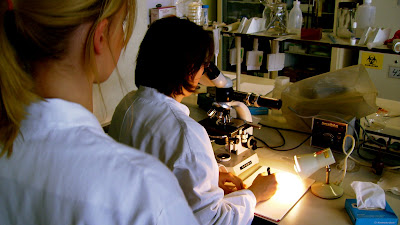 0
comments
16 October 2007
0
comments
16 October 2007
On 2 October 2007, the class of History, Role, and Impact of the Natural Sciences was invited to spend a day in the biomedical laboratory of the Veterinary Medicine Faculty. Lecturers Peter Koolmees and Monique Tersteeg had prepared a programme to familiarise the students with the various methods and approaches applied by biomedical scientists. In order to accomplish this, the central question was raised: How do muscles work? For students coming from a whole different background (history and/or physics), this question was not so easily answered. This concise report will describe what I have observed, done, and learned that day in the laboratory.
As in any biomedical research, we started off by posing hypotheses in an attempt to explain the mechanism behind muscles. Naturally we could tell that muscles are attached to bones, describe the various body movements a muscle performs, and identify different kinds of muscles in the body (biceps, heart). However, these descriptions do not explain how muscles really work, and therefore an experiment needed to be formulated: we take three pieces of meat (chicken, beef, and pork), and we attempt to isolate fibres from the various muscle tissues. We use the magnifying glass and the microscope to look closer at each of the the muscle tissue, recognising differences and similarities.
During this research, we learned the technique of microscopy, the various sorts of microscopes (stereo, light), and about the actual substance of muscles. The study of histology taught us that muscles are formed of columns of elongated cells called fibres containing interlocking parallel arrays of the proteins actin and myosin.
The aim of the day in the laboratory, however, was not to come to an explanation of how muscles exactly work, rather to use the question as an illustration to show the development of biomedical methodologies and the acquisition of scientific knowledge. The study of histology has developed since 1840, and ever since biomedical scientists have been describing the structure of cells in all kinds of tissues. This kind of study is, technically speaking, much different from the kind of study a historian or theoretical physicist would do. But in essence, we can recognise that all devote time and attention to acquire knowledge by means of a detailed investigation and analysis. Whether this investigation is focussed on academic books, heavenly bodies, or organic tissues, it should not make a difference.
Then why this day in the laboratory? In my opinion, it was of great usefulness. As future historians of science, it is imperative to not only took at the produced works by scientists, but also to look at their socio-economic context, their cultural conceptions of the world, and the technical possibilities and inventions. When a historian can place himself/herself into the shoes of scientists, the historian gains new insights into the development of science, which, in turn, is an other acquisition of knowledge.



